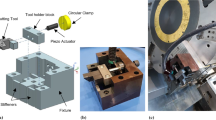Vibration suppressions techniques in cutting tools can save old machines and enhance design flexibility in new manufacturing systems. The finite element method is employed to investigate structural stiffness, damping, and switching methodology under the use of smart material in tool error attenuation. This work discusses the limitations of using lumped mass modeling in toolpost dynamic control. Transient solution for tool tip displacement is obtained when pulse width modulation (PWM) is used for smart material activation during the compensation of the radial disturbing cutting forces. Accordingly a Fuzzy algorithm is developed to control actuator voltage level toward improved dynamic performance. The required minimum number of PWM cycles in each disturbing force period is investigated to diminish tool error. Time delay of applied voltage during error attenuation is also evaluated. Toolpost static force–displacement diagram as required to predict voltage intensities for error reduction is tested under different dynamic operating conditions.
Similar content being viewed by others
References
Abboud, N. N., Wojcik, G. L., Vaughan, D. K., Mould, J., Powell, D. J. and Nikodym, L. (1998) Finite element modeling for ultrasonic transonic transducers. Proceedings of the SPIE International Symposium on Medical Imaging 1998, San Diego, 21–27 Feb, pp. 1–24
Allik, H. and Hughes, T. J. R. (1970) Finite element method for piezoelectric vibration. International Journal for Numerical Methods in Engineering, 2, 151–157
Bathe, K. J. (1982) Finite Element Procedures in Engineering Analysis, Prentice-Hall Inc, pp. 511–537
Berlincourt, D. and Krueger, H. A. (2000) Properties of Morgan electroceramic ceramics, Technical Publication TP-226, Morgan Electro Ceramics
Dold, G. (1996) Design of a microprocessor-based adaptive control system for active vibration compensation using PMN actuators, MS Thesis, University of Maryland at College Park
Eshete, Z. (1996) In process machine tool vibration cancellation using electrostrictive actuators, Ph.D. Thesis, University of Maryland at College Park
Fleming, A. J., Behrens, S. and Moheimani, S. O. R. (2002) Optimization and implementation of multimode piezoelectric shunt damping systems. IEEE/ASME Transactions on Mechatronics, 7(1)
Frankpitt, B. A. (1995) A model of the dynamics of a lathe toolpost that incorporates active vibration suppression, Institute for System Research, University of Maryland at College Park
Gopalakrishnan, V., Fedewa, D., Mehrabi, M. G., Kota, S. and Orlandea, N. (2002) Design of reconfigurable machine tools. ASME Journal of Manufacturing Science and Engineering, 124, 483–485 (Technical Briefs)
J. F. Hurtado S. N. Melkote (2001) ArticleTitleImproved algorithm for tolerance-based stiffness optimization of machining fixtures ASME Journal of Manufacturing Science and Engineering 123 720–730
R. Lerch (1990) ArticleTitleSimulation of piezoelectric devices by two-and three-dimensional finite elements IEEE Transactions on Ultrasonics, Ferroelectrics, and Frequency Control 37 IssueID3 233–247
Luan, J. and Lee, F. C. (1998) Design of a high frequency switching amplifier for smart material actuators with improved current mode control. PESC 98, Vol. 1, pp. 59–64, Fukuoka, May
Merritt, H. E. (1965) Theory of self-excited machine-tool chatter. Journal of Engineering for Industry, November, 447–454
Moon, Y. and Kota, S. (2002) Design of reconfigurable machine tools. ASME Journal of Manufacturing Science and Engineering, 124, Nov., 480–483 (Technical Briefs)
Passino, K. M. and Yurkovich, S. (1998) Fuzzy Control, Addison Wesley Longman, Inc
Piefort, V. (2001) Finite element modeling of piezoelectric active structures, Ph.D. Thesis, ULB, Active Structures Laboratory, Department of Mechanical Engineering and Robotics
Roark, R. J. and Young, W. C. (1975) Formulas for Stress and Strain, 5th edition, McGraw-Hill Book Company, New York, Table 24–1j, p. 337
H. S. Tzou C. I. Tseng (1990) ArticleTitleDistributed piezoelectric sensor/actuator design for dynamic measurement/control of distributed parameter systems: a piezoelectric finite element approach Journal of Sound and Vibration 138 IssueID1 17–34
Zhang, G., Ko, W., Luu, H. and Wang, X. J. (1995) Design of a smart tool post for precision machining. Proceedings of the 27th CIRP International Seminar on Manufacturing Systems, Ann Arbor, MI, May, pp. 157–164
Zienkiewicz, O. C. and Taylor, R. L. (2000) The Finite Element Method, 5th edition Vol. 1: The Basis, Butterworth-Heinemann
Zienkiewicz, O. C. and Taylor, R. L. (2000) The Finite Element Method, 5th edition Vol. 2: Solid Mechanics, Butterworth-Heinemann, pp. 423–424
Author information
Authors and Affiliations
Corresponding author
Rights and permissions
About this article
Cite this article
Rashid, M.K. Fuzzy algorithm and structural stiffness in error attenuation of intelligent toolpost. J Intell Manuf 16, 277–286 (2005). https://doi.org/10.1007/s10845-005-7023-6
Issue Date:
DOI: https://doi.org/10.1007/s10845-005-7023-6



